"A tragedy of guilty victims”? The memory of the Roma genocide in postwar Ukraine, part 2 : Knowledge “for internal use,” or the “tip of the iceberg”: Channels of information and the formation of the picture of the occupation
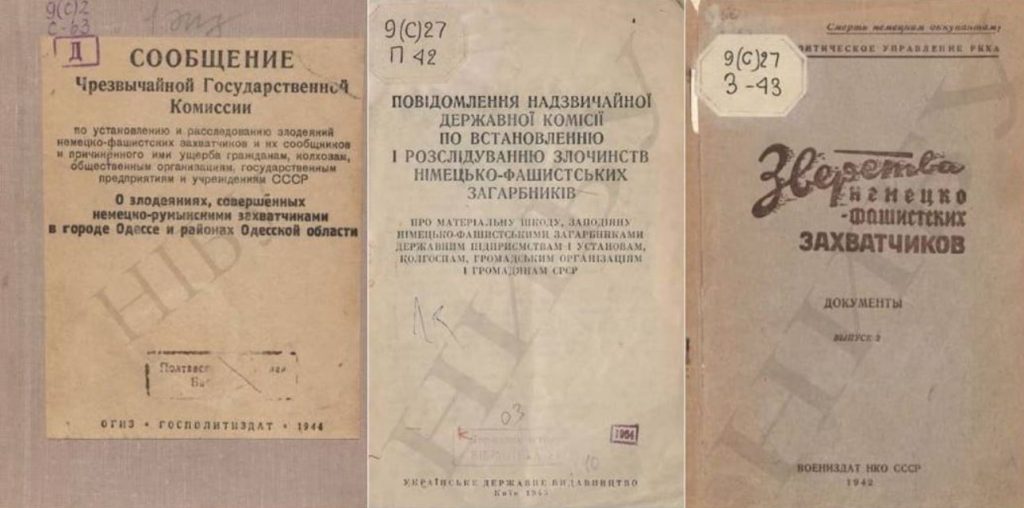
The second part of the article examines the “tip of the iceberg” of the Soviet culture of memory of the victims of the Roma genocide, that is, the documentation of the occupation period which the Soviet authorities deemed necessary to reveal to the public. How did Roma victims appear in both official collections about the “atrocities of the German-fascist occupiers” and in periodical publications from the central, republican, oblast, and even raion levels? To what degree did information about the Roma tragedy disseminate into the public sphere from the materials of criminal trials of the people whom the Soviet security organs were prosecuting? Did the construction of the myth about the “Great Patriotic War” by the authorities affect the manner in which Roma victims were represented? What perceptions about the causes of the Roma’s persecution by the Nazis could have been formed in the mind of readers of the memoirs written by former Soviet underground members and partisans?
Mykhail Tyaglyy
Serial publications based on NDK documents
As we know, the documentation generated by lower-level branches of the Extraordinary State Commission (NDK) remained practically inaccessible to the Soviet audience until the collapse of the USSR (with the exception of individual historians who were granted access to archives during the writing of their studies adhering to strict ideological parameters). However, it was impossible not to utilize such significant material to produce knowledge about the war. On the basis of this NDK documentation, twenty-seven announcements were prepared and published as early as 1943–1945. [1] The Soviet government’s propaganda work in the sphere of publicizing materials on the crimes of the Nazi regime was not limited to these publications. Already on 24 September 1941 the Unified State Publishing House (OGIZ) and the State Publishing House for Political Literature (Gospolitizdat; Ukr. Derzhpolitvydav) launched a series of brochures entitled Atrocities of the German Fascists. The first brochure contains six chapters describing the basic types of crimes committed by the occupation regime. Over the course of a single year (from June 1941 to the fall of 1942), approximately forty authored brochures and collections of documents about looting, the exploitation of captured territories, and crimes against the civilian population were published. [2]
The most active in this sphere were Derzhpolitvydav, which was under the Central Committee of the Communist Party (twenty-eight publications) and the Military Publishing House of the People’s Commissariat of Defense, which issued, among other materials, a series of brochures entitled Atrocities of the German-Fascist Invaders: Documents (fifteen publications). Both of these publishing houses issued both general publications on Nazi crimes in their occupied territory, as well as publications on individual cities, oblasts, and republics of the USSR. In addition, various Soviet republics issued serial publications featuring materials on the Nazi-occupied territories of the USSR. In Kyiv, for example, the Ukrainian State Publishing House issued at least seventeen brochures highlighting Nazi crimes both in Ukraine in general and in its individual oblasts. Publishing houses based in various cities also published brochures on this topic. For the most part, all these publications used NDK documents or contained authored texts based on them. We have at our disposal approximately eighty publications that help to formulate the following question: Did the tragedy that befell the Roma leave any kind of trace in their contents? If so, in what form does it appear before readers?
The historian Andrej Kotljarchuk takes the view that the report about the mass shootings of 176 settled Roma in the village of Aleksandrovka, near Smolensk, on 24 April 1942, which the NDK published in 1945, was the only official document published in the Soviet Union about the Nazi-engineered Roma genocide. [3] The results of research efforts provide grounds for stating that significantly more of them were published. Below is a list of ten works devoted to the fate of the Roma in seven different publications:
- P. Vagin and M. Nikitin, Pod igom gitlerovskikh palachei (Moscow: OGIZ-Gospolitizdat, 1943).
– “On the orders of the German command, the Vyshgorod commandant’s office of Pozherevits raion [part of Leningrad and Pskov oblasts in 1939–1958—Author], having shot 200 gypsies, carried out a mass poisoning of their children. The German monsters daubed poison on the children’s lips from which they died instantly” (pp. 16–17). - Dokumenty obviniaiut, vyp. 2 (Moscow-Gospolitizdat, 1945).
– The shooting of gypsies near Smolensk by the Germans. From the testimonies of citizeness P. Bryzgalova, a resident of Smolensk. From the declarations of citizeness A. N. Pavlova, a resident of Smolensk (p. 107). [Two eyewitness testimonies are cited—Author].
– Report on the atrocities and evil deeds perpetrated by the German-fascist troops in the city of Mariupol.
“The same fate [like that of the shot Jews—Author] befell the entire gypsy population of the city” (p. 292). - Zverstva nemetsko-fashistskikh zakhvatchikov: Dokumenty, vyp. 12 (Moscow: Voennoe izdatel′stvo, 1944).
– Report on the atrocities and evil deeds perpetrated by the German-fascist troops and authorities in the city of Mariupol.
“The same fate [like that of the shot Jews—Author] befell the entire gypsy population of the city” (p. 24).
– German atrocities in Mogilev oblast. Report. Drawn up on 6 October 1943.
“In the spring of 1943 the police arrested 45 gypsies (among them were elderly people, women, and children). The gypsies were taken to the village of Gorky and shot there” (p. 55). - Zverstva nemetsko-fashistkikh zakhvatchikov: Dokumenty, vyp. 13 (Moscow: Voennoe izdatel′stvo NKO, 1944).
– German atrocities in Kherson.
“A terrible fate befell all the gypsies living in the vicinity of the c[ity] of Kherson. At first, the Germans announced to the gypsies that they were assembling them for dispatching to their fatherland, to Romania. Once approximately 300 gypsies had gathered, they were shot near the city jail and dumped into a pit in the vicinity of the ramparts” (p. 53). - Zverstva nemetskikh izvergov: Sbornik materialov o chudovishchnykh zlodeianiiakh nemetsko-fashistskikh zakhvatchikov v Leningradskoi oblasti (Leningrad: Voennoe izdatel′stvo NKO, 1944).
– “A settled family of gypsies (7 persons) was living in the village of Slapi. The mother and one son were shot during the first month of the occupation. The following was done several times to the remaining members of the family: They were brought to the cemetery, forced to dig graves for themselves, then they were let go with the words, ‘Go. Work better at the Koenig plant. Maybe you’ll manage to earn the right to live” (p. 16). - O zlodeianiiakh nemetsko-fashistskikh zakhvatchikov v gorode Orle i Orlovskoi oblasti (Moscow: OGIZ-Gospolitizdat, 1943.
– “The following took place in August 1942: The Germans forced four prisoners to dig a grave. In that grave they shot 8 gypsies; they also shot the four who had dug the grave” (p. 7). - Sbornik soobshchenii Chrezvychainoi gosudarstvennoi komissii o zlodeianiiakh nemetsko-fashistskikh zakhvatchikov (Moscow: OGIZ-Gospolitizdat, 1946).
– About the evil deeds of the German-fascist invaders in the city of Orel and Orel oblast.
“The following took place in August 1942: The Germans forced four prisoners to dig a grave. In that grave they shot 8 gypsies; they also shot the four who had dug the grave” (p. 52).
– About the destruction and evil deeds perpetrated by the German-fascist barbarians in the Pushkin Preserve of the Academy of Sciences of the USSR.
“The German military commandant’s office carried out the shooting of gypsies, including women and children, living in Vyborg, Pushkin, and Novorzhevsk raions with particular sadism and cruelty. They were shot only because they were gypsies” (p. 259).
Information about the killing of Roma appears only in seven out of approximately eighty publications (which contain information, including about those places where the Germans carried out anti-Roma reprisals). Two brochures include information about more than one locale. However, there are cases where one and the same information is repeated in various brochures. The contents of the cited data are quite brief (with the exception of an incident that took place near Smolensk, where many residents of a Roma collective farm were killed). It is difficult to judge whether during the compilation of brochures there were any rules for selecting information about the death of Roma. We remind readers that, according to estimates made within the framework of this study, lower-level branches of the NDK in the Ukrainian SSR alone documented approximately sixty incidents in which Roma were killed (excluding the Crimean Peninsula, which time was then part of the RSFSR).
The above-mentioned publications present only two such locations: Mariupol and Kherson (as well as four on the territory of Russia and one in Belarus). Thus, only a small fraction of the information on the Roma genocide collected by the main Soviet government body investigating events during the occupation period made it into the public domain.
Periodical publications: The central press during wartime
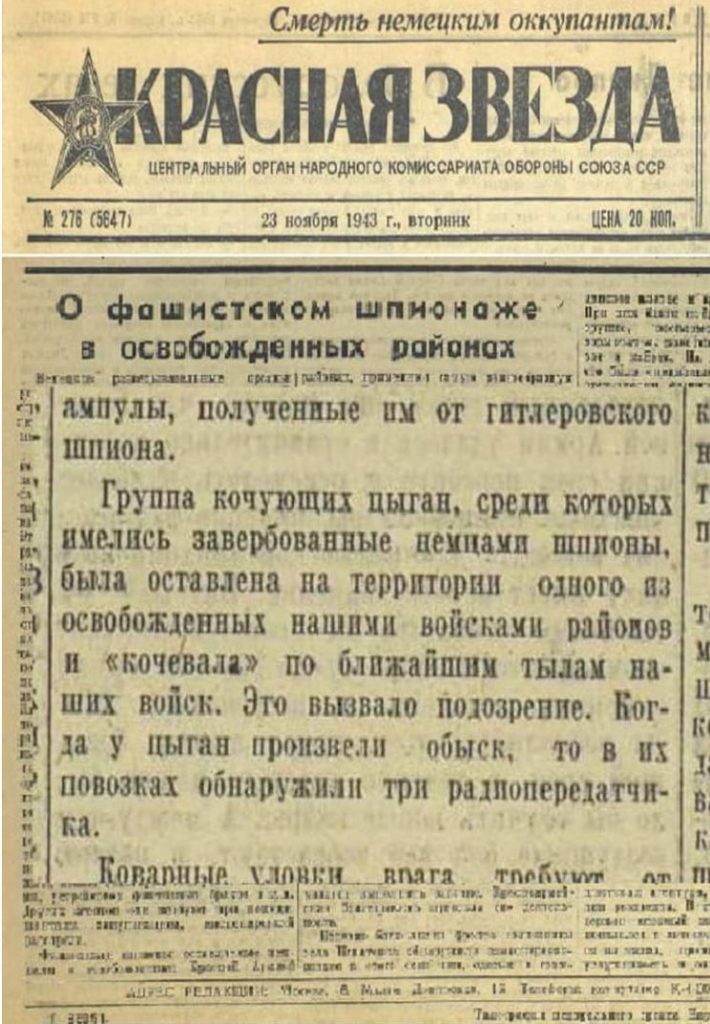
In addition to individual serial publications featuring NDK documents or the outlines that were prepared on the basis of the former, the commission’s main materials were also published in the press. However, publications in the postwar Soviet media were not limited to them alone. As soon as Soviet power was restored in one populated area or another, efforts were immediately launched to rebuild the Soviet public space and, especially, the reading audience, by means of central newspapers published in Moscow as well as republican and local publications.
Kotljarchuk examined articles from three major, central newspapers of the USSR: Izvestiia, Pravda, and Krasnaia zvezda for the years 1943–1944 and 1945–1946. He discovered eleven articles in Pravda and Izvestiia that reported on the mass destruction of Roma by the Nazis and their allies (no such reports were found in Krasnaia zvezda. [4] He concluded that “information about the mass destruction of Roma was not completely glossed over by Soviet propaganda, although on the whole it was of an extremely marginal nature,” and “the Soviet leadership not only knew about the Roma genocide committed by the Nazis but also grasped the exceptional character of their total destruction.” [5] In some wartime publications, Soviet media emphasized that the Nazis’ extermination of the Roma was motivated exclusively by racial goals. [6]
In agreeing with Kotljarchuk’s conclusions, I should add that during the wartime period Krasnaia zvezda (the central organ of the People’s Commissariat of Defense of the USSR) mentions the Roma at least seven times as victims of the Nazi regime and their allies. In its 1 July 1941 issue, a note entitled “Terror in Croatia,” the newspaper reports that “Serbs, Jews, and gypsies” are experiencing discrimination in this country.” On 13 April 1943 a lengthy article written by the head of the Council of People’s Commissars of the Latvian SSR, entitled “Soviet Latvia under the yoke of German occupation,” notes: “In the cities and villages of Letgale [one of the four historical and cultural regions of Latvia—Trans.] all the Jews and gypsies have been killed. The same took place in Kurzeme [Courland—Trans.] and Vidzeme. Gypsies were brought to the town of Ludza from all adjacent volosts, and entire families were suffocated by gas in former butcher shops on the market square.”
In its 7 September 1943 issue Krasnaia zvezda published an NDK statement entitled “About the crimes of the German-fascist invaders in the city of Orel and Orel oblast”—about the shooting of eight Roma in a grave that they had dug themselves. On 29 August 1944, the newspaper also published an NDK announcement, with which we are already familiar, from the Pushkin Preserve of the Academy of Sciences of the USSR, which repeats a phrase that appeared all too rarely in the Soviet media: that the victims “were shot only because they were gypsies.” Roma are mentioned twice in the newspaper in the context of acquainting readers with the horrors of Auschwitz. On 10 April 1945 the author of an article entitled “We were saved by the Red Army” and subtitled “A letter from the wife of the regent of Yugoslavia,” writes the following about the conditions in the camp: “From Camp A we were transferred to the ‘gypsy’ camp. We asked: Where are the gypsies? One woman, whom the Germans had forced to work near an oven, told me that in liquidating the gypsy camp, the Germans burned over 10,000 elderly people, women, and children. They sent able-bodied men to work in Germany.”
In terms of detail, these information items differ from what is known today about the fate of the Sinti and the Roma in Auschwitz. However, they generally gave readers a completely unambiguous sense of the genocidal essence of Nazi policy. On 8 May 1945 the newspaper also mentions the existence of a “gypsy” camp in Auschwitz in an NDK statement entitled “About the horrific crimes of the German government in Auschwitz.”
The considerably more frequent mentions of Roma in the pages of this newspaper (in comparison with Pravda and Izvestiia) are not surprising. As we can see, most of these mentions were not the result of editorial policy or authors’ initiatives. They were merely the consequence of the fact that NDK announcements about the crimes of the Nazi regime were run more often in this newspaper. There is another obvious reason: Krasnaia zvezda was an army newspaper, and reports about Nazi atrocities were aimed at mobilizing fighters to the struggle against the occupying regime.
However, one particular article compels us to examine this problem from a completely different angle and to see Krasnaia zvezda as a typical army newspaper with its inherent military perception of certain issues. As regards the Roma, this meant seeing a threat in the nomadic camps and treating all “nomadic gypsies” as potential spies. In an article entitled “About fascist espionage in the liberated districts” (23 November 1943) author A. Spektorov provides a detailed description of secret agent work and espionage activities organized by the occupiers in the territories that they had abandoned. The author appeals for vigilance regarding encampments of nomadic Roma: “A group of nomadic gypsies, among whom were spies recruited by the Germans, was left on the territory of one of the raions liberated by our troops, and they ‘roamed’ about the closest rear areas of our troops. This triggered suspicion. When a search of the gypsies was carried out, three radio transmitters were discovered in their wagons.”
This material could potentially have led to xenophobia and ethnic profiling “in combat conditions.” Without doubt, it in no way contributed to helping Red Army soldiers form an attitude to nomadic or semi-nomadic Roma groups as surviving victims. The article refuted the view formed by rare official reports about the Roma as the objects of the Nazi genocide. Furthermore, it practically turned the image of the nomadic gypsies into that of an enemy.
Periodical publications: the central press during the postwar period
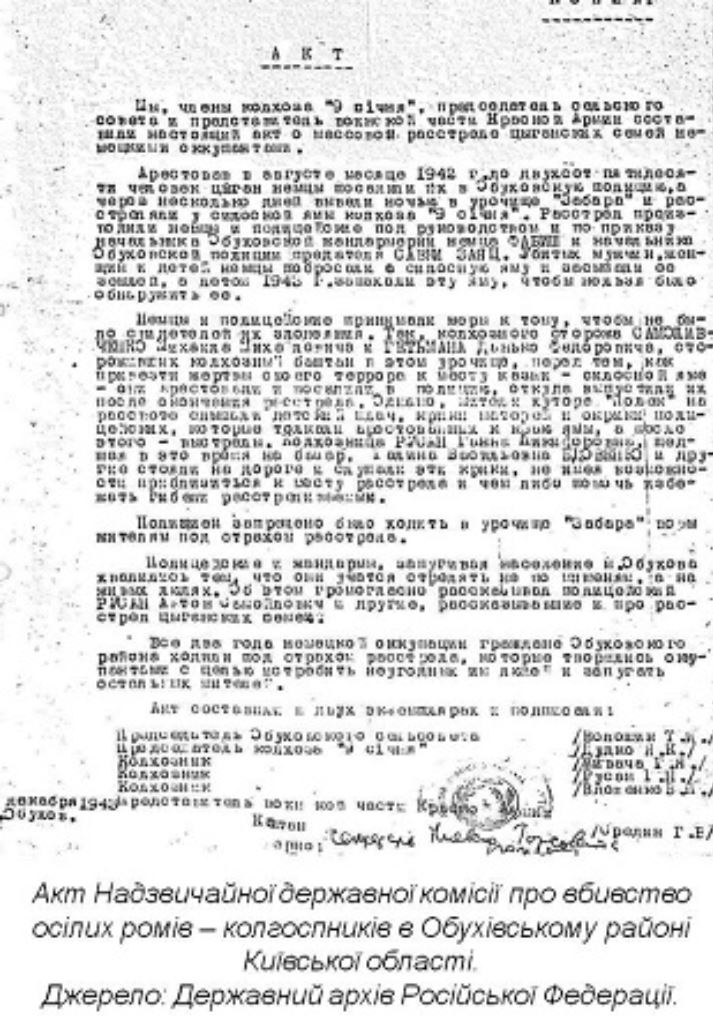
Pravda and Izvestiia, like other All-Union and republican newspapers in the USSR, covered the course and outcome of the International Military Tribunal in Nuremberg. The crimes against the Roma were mentioned in them to the same extent as they appeared in the materials of the tribunal; that is, always in passing. Moreover, central newspapers also ran reports about the open trials of Nazi criminals and their local accomplices taking place in various cities of the USSR (on these trials, see below). For example, on 12 January 1946 Pravda and Izvestiia published identical items about the Mykolaiv Trial, which noted that the defendant, the former head of the SD in Mykolaiv, “is also accused of the shooting of 1,500 civilians, the mass use of torture and torment, the total destruction of the Jewish population of the oblast, as well as gypsies.” [7] In January 1946 Izvestiia published a report on the Riga Trial, in which the defendant was the notorious Friedrich Jeckeln (former Higher SS Leader). “During the course of the judicial investigation the active participation of the defendant and the troops subordinated to him in the destruction of Soviet citizens of gypsy, Polish, and Jewish nationalities is being established,” the newspaper wrote. [8] In June 1946 Pravda published an announcement about the Supreme National Tribunal in Poznań regarding the case against Arthur Greiser, the former Gauleiter and Reichstatthalter of Wartheland. Among the victims of SS crimes in Poznań, the newspaper also mentions “Roma mauled to death by dogs.” [9] Occasionally, such materials ran alongside reports from Nuremberg.
In subsequent years the frequency of the occurrence of information about Roma as victims of Nazism depended on how often similar trials—of Soviet citizens—took place in the USSR. This was also determined by the level of the Soviet Union’s interest in covering the prosecutions of former Nazi criminals abroad or by the desire to reproach governments behind the Iron Curtain for their absence. For example, on 11 September 1949 Izvestiia and Pravda published identical notes on the trial of the former general Erich von Mannstein in Hamburg. “The indictment mentions the mass destruction, on Mannstein’s orders, of Jews and gypsies, particularly the entire Jewish population in the city of Kerch,” Izvestiia wrote. [10]
In 1962 Izvestiia published materials on the trial in the city of Tartu of the three heads of the local Nazi concentration camp. Two of them were tried in absentia because they had found refuge abroad. The defendants were accused, among other things, “of having carried out mass shootings of employees of Soviet organs, prisoners of war, writers and academics, Jews, and gypsies” in an anti-tank trench near the concentration camp. [11] Four years later Izvestiia informed its readers about the Mykolaiv Trial of eleven “Nazi accomplices,” who were officials of the Selbstschutz, a local self-defense detachment. According to the newspaper, their tasks included “support for the occupying regime, the destruction of communists and Soviet activists, the destruction of Jews and gypsies.” [12]
On the one hand, Soviet readers got a sense that the Roma were one of the groups of victims and, on the other, they were not given explanations of why the Roma were among the victims. Hereafter, everything depended on many contexts and readers’ ability to analyze this information.
The republican, regional, and local press
Along with central periodicals, regional newspapers also took part in forming a picture of the war; they were important for the reading audience because of their stronger connection to local realities and problems. For a long time, researchers of Soviet history thought that the ideological and media instructions from the Soviet state center were implemented obediently, straightforwardly, and unswervingly by republican and regional media. Recent research suggests, however, that this information product should be considered more as a result of the interaction between the center’s instructions and local press organs (while maintaining the undisputed primacy of the center in this process). In other words, local authors and publications had a limited range of possibilities within which they could choose one option or another to articulate questions, including those touching on recent history. [13]
In order to investigate the extent to which information about the Roma genocide was covered in the Ukrainian press during the wartime period, I examined materials stored in the newspaper collections of the V. Vernadsky National Library of Ukraine: the Radianska Ukraina collection. I also examined newspapers that were published in 1944 and 1945 in several locales in Ukraine immediately after the restoration of Soviet rule (about which we know that large-scale Nazi reprisals against the Roma took place in them or nearby). The specific newspapers are listed below:
- Artemovskii rabochii. In the spring of 1942 up to 900 Roma were killed in the city of Artem (today: Bakhmut), Donetsk oblast.
- Vilna pratsia. In May 1942, 160 Jews and Roma (the majority were Roma) were killed near the town of Pyriatyn, Poltava oblast, where this newspaper later started coming out.
- Desnianska pravda. This oblast newspaper was published in Chernihiv, where in 1942, during the occupation, up to 2,000 Roma from Chernihiv as well as surrounding populated areas were killed.
- Chervona Lubenshchyna. Raion newspaper that resumed publication after the occupation of the town of Lubny, Poltava oblast, in the vicinity of which approximately 250 Roma were killed in the spring of 1942.
- Radianskyi Malyn. Newspaper of the Malyn raion center, Zhytomyr oblast, where approximately 300 Roma were killed in the summer of 1942.
- Chervonyi stiah. Newspaper of the Smila raion center, Cherkasy oblast, where approximately 200 Roma were killed.
- Kolektyvist. Newspaper of the Lityn raion center, Vinnytsia oblast, where up to 150 Roma were killed in the summer of 1942.
- Radianskyi shliakh. Newspaper of the Sarny raion center, Rivne oblast, where up to 200 Roma were killed in August 1942.
- Vilna pratsia. Near the town of Obukhiv, Kyiv oblast, where this newspaper was published, 150 Roma members of a collective farm were killed in August 1942.
The Kyiv-based, republican newspaper Radianska Ukraina, whose files were studied for the period from March 1942 (when it was called Komunist) to December 1945, offered intensive coverage of the crimes of the occupying regime as Ukrainian territories returned under Soviet control (from the spring of 1943, starting in the Donbas and Kharkiv oblast, and later farther westward). A substantial number of articles was based on the documentation collected by the Ukrainian branch of the NDK. However, there was also a considerable number of authored materials. Starting in 1945 reports from the Nuremberg International Tribunal and materials from the Ukrainian SSR that were prepared for the Tribunal occupy a prominent place in the newspaper's output (they appeared in the column “Ukraine Accuses”). Information about crimes against the Jewish population was often published openly, occupying a prominent place both in essays on the evolution of National Socialism in the Third Reich and in accounts of Nazi crimes in occupied countries and territories (including Ukraine).
From time to time the newspaper published NDK reports or essays on the evildoings of the occupiers in one locale or another, where, as documents indicate, reprisals against Roma also took place. However, it is more likely that such information was not included in published articles. For example, on 16 December 1945, the newspaper published an abridged report about Nazi crimes in the city of Vasylkiv, Kyiv oblast, where, according to various sources, fifty-two Roma families that had been rounded up in the entire district were killed, but there is no information about this in the article. Roma are not mentioned in the following articles either: “In the Chernihiv region” (19 September 1943), “Behind bloody traces”—about the crimes of the occupiers in the city of Nizhyn (6 October 1943 ); “The evildoings of the German occupiers in Pyriatyn” (13 October 1943); “The Artemiv tragedy” (3 December 1943); and “The crimes of the occupiers in the Odesa region” (6 June 1944). Mass reprisals against the Roma population took place in all these populated areas during the occupation.
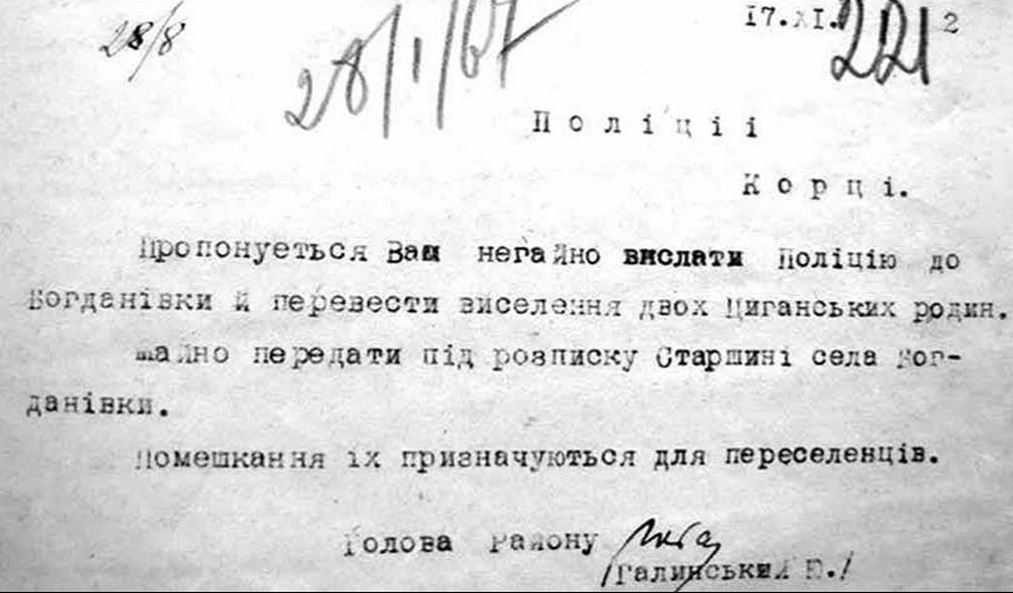
The lengthy article “The Trypillia tragedy,” about events that took place in the town of Obukhiv, Kyiv oblast, during the occupation, which was published on 13 February 1944, is quite revealing. In August 1942, 250 Roma were killed on a collective farm not far from Obukhiv. The report on this event, drawn up by the NDK, is exceptional, as it is only one of a handful of very detailed descriptions of the Roma genocide. The article reveals the exact place and time of the crime, the names of German and local perpetrators, and the circumstances surrounding the murders. Yet, once again, there is not a single word about the Roma. On 18 and 21 December 1945 the newspaper published a detailed report about the trial concerning the German-fascist atrocities that were committed in Smolensk and Smolensk oblast (where the residents of a Roma collective farm in the village of Aleksandrovka were killed). However, the Roma are not mentioned.
Regional newspapers showed a similar tendency, despite the fact that they seemed to be closer to local events and had material at hand. It is worthwhile noting that information about systematic reprisals against the Jewish population is encountered quite often in articles published in Radianska Ukraina as well as in oblast and raion newspapers. And even though some articles used the euphemism “peaceful Soviet citizens” to define this group of victims (although even here, judging by the size of the group described and the additional associations that were triggered by the names mentioned in the text, the circumstances of the murder, etc., readers could easily understand who was being discussed), in many others ethnic affiliation was stated openly. In the case of Roma victims, their relatively small numbers and the impossibility of distinguishing their names from local Slavic ones made them unrecognizable, even if the descriptions of their fate were quite detailed.
“They will not forget the bloody reprisal against the Jewish population, when they were driven from the ghetto to a pit, when they were forced to remove their shoes and take off their outer clothing, forced to jump into the grave, to lie down in rows on top of half-dead corpses of people, after which the Germans, firing off rounds, forced the latter to fall silent forever […] They will not forget the day, 18 May 1942, when the Hitlerites, drunk on blood, with a black swastika on their sleeves, with a black submachine gun in their hands, transported more than 80 communists in closed cars,” wrote the newspaper Vilna pratsia about the events that took place at the Pyrohova Levada tract near the town of Pyriatyn, where on 18 May 1942, in addition to the two named groups of victims, a third one—at least several dozen Roma—were killed. However, there is no mention of them.
Trials of local participants in Nazi crimes
Besides the documentation of Nazi crimes by the NDK organs, another key sphere in which knowledge and collective perceptions about the occupation period were formed deserves attention. It is difficult to call this sphere of activity (and the type of documentation that it generated) merely “closed” or “public.” Even during the period when this activity was entirely closed off from society, it still had a specific but indirect effect on it. At issue here are the investigations and trials that took place during the war and which lasted until the dissolution of the USSR of those who had committed crimes against the population on the occupied territory: the Germans (representatives of various branches of the occupation apparatus) and their allies as well as locals who served in administrative or law-enforcement agencies. Whereas the number of convicted people from the first group was insignificant, the second category (Soviet citizens) was characterized by a colossal number of people who were prosecuted during the postwar period.
Research on this topic has markedly intensified in recent decades. Today rough statistics are available on the number of people who were convicted in the USSR on the whole and in individual republics [14]; we now have an idea of the composition of the incriminated crimes and the sentences that were handed down [15] and of the legislative base that regulated trials. [16] It is important that we have not only a factographic picture but also interpretations of the essence, goals, and purpose of the investigative and trial processes in the context of Soviet ideology and the needs of the state. [17]
Even so, thus far researchers have focused attention only on a few of the trials that took place in the first postwar years (considered “open” or “public”): Kharkiv, Krasnodar, Kyiv, etc. (twenty-one trials between 1943 and 1949). However, even a cursory review of regional Ukrainian periodicals allows us to determine that such smaller-scale, open trials (during which not just German soldiers and their allies but also local “accomplices” were prosecuted) took place in practically every oblast center as well as in many raion ones. The next wave of public trials of “local significance” began in the second half of the 1960s and the 1970s.
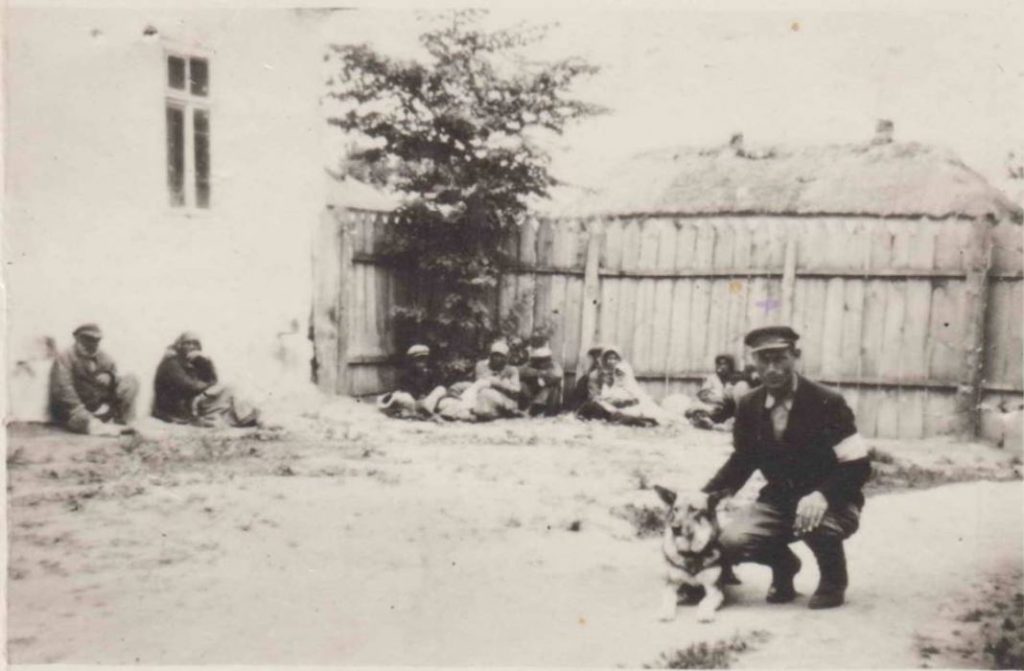
Of course, many more trials took place behind closed doors. Even though their course and outcomes did not become known to the community, there are grounds for supposing that they had an effect on the Soviet people’s mass perception. In particular, they formed an idea of which groups were thought to have suffered, what kind of punishments were stipulated for acts pertaining to one stratum of the population or another, as well as how crimes against various groups of victims were reflected in indictments and, accordingly, in the sentences. Among the tens of thousands of archived investigative cases that are stored today in the archive of the Security Service of Ukraine in Kyiv and the archives of SBU oblast directorates, fifty cases were found in which the indictments mention crimes against the Roma population.
The importance of these sources for studying the Roma genocide is difficult to overestimate. Over one-third of the available facts about the mass killings of Roma was established on the basis of these materials. The latter are characterized by a number of features that changed depending on the period in which an investigation took place. Cases from the wartime period and the first postwar years are characterized by their particular brevity. Approximately three-quarters of the cases were conducted in the early postwar period. From a quantitative standpoint, they contain extensive but qualitatively less important information. Investigative materials dating to the 1950s and especially the 1960s, when the second wave of punishments was handed down to those accused of collaborating with the occupying regime, became much more extensive, more detailed, and more thorough. During this period the reconstruction of the defendants’ actions was carried out not just with the aid of reports on the interrogations of accused, witnesses, and face-to-face confrontations, but also new types of investigative methods. For example, “scene reconstruction reports” were used (the accused or witnesses traveling to the scene of the crime; the use of photographs and maps recording his testimonies and witness statements). In addition, victims’ remains were exhumed and subjected to a forensic examination.
In the first postwar years investigators were primarily interested in the actions of those under investigation against Communist Party activists and Soviet functionaries, prisoners of war, underground members, and partisans—in other words, all those who had mounted resistance to the occupying regime. Crimes against Jews and Roma were also documented. In this case, however, investigators did not seek to record details. The exact dates, place, and time of the crime are often missing in these descriptions or recorded very approximately (or they deviate from the facts established by the local NDK). In addition, it was important for an investigation to prove that a crime had been committed. But it very rarely sought to establish a motive. This makes it impossible for us today to answer the question of why local policemen sometimes carried out arrests and reprisals against Roma even without an obvious order from the German leadership (according to documents, this is nearly half of all cases involving the killing of Roma with the participation of local policemen). It is also important to note that of the fifty cases that examined the killing of Roma, only three record the testimonies of Roma (survivors or their relatives).
The question arises: To what extent did the materials on the fate of the Roma, which were amassed by the Soviet investigative and judicial authorities, leave the confines of investigators’ offices, NKVD prisons, and courtrooms? During the early postwar decades this barely happened. Apart from the well-known public trials of the first years after the occupation, local trials (also open) were held in many oblast and raion centers, but they have never been studied. Such trials took place in 1944 in the cities of Chernihiv [18], Shostka (Sumy oblast), and Artemivsk (today: Bakhmut, Donetsk oblast). In all three of these populated areas, Roma constituted a significant share of the victims of the occupation. These trials were covered by the local press (the newspapers Desnianska pravda [19] in Chernihiv; Zoria [20] in Shostka; and Artemovsky rabochii in Artemivsk [21]). Nevertheless, not a single word is mentioned about Roma victims.
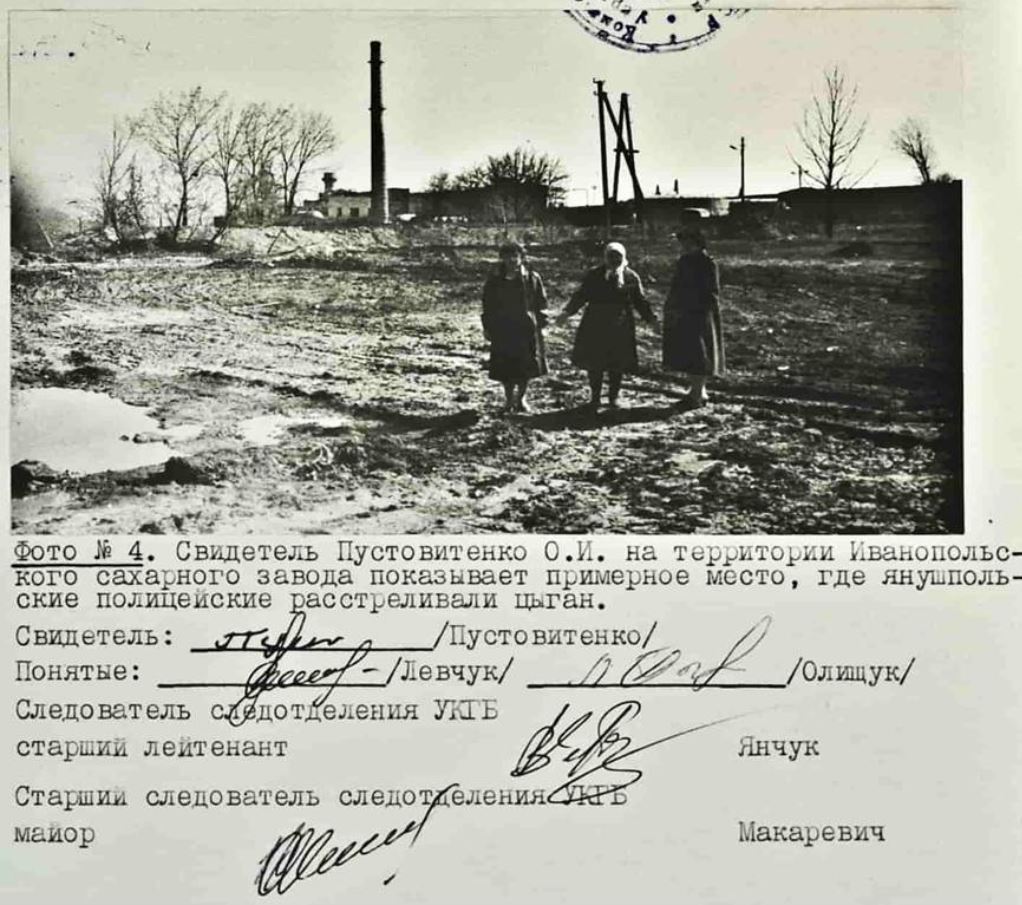
The materials of forensic investigations during the second wave paint a somewhat different picture. Those pertaining to the investigation of the crimes committed by local policemen in a populated area of Zhytomyr oblast—the large village of Ivanopil (called Yanushpol during the war)— clearly demonstrate the differences between the work of the investigative and judicial system in the 1940s and in the late postwar period. In May 1942, by order of the local gendarmerie, the raion police detained over forty nomadic Roma in the woods near the village of Molochky. A few days later a group of policemen, commanded by the SD chief of Berdychiv and the chief of the raion police, transported the Roma to a pit near a sugar plant, where SD members and policemen shot them. [22]
Approximately twenty local policemen were involved in this crime. Some of them were subsequently prosecuted. The first wave of investigations of four of them took place between 1947 and 1953. [23] Thanks to these investigative materials, we know the exact date of the crime, the approximate number of victims, the place where the Roma were shot and buried, and the personnel composition of the perpetrators. In the late 1980s, two more former policemen were prosecuted. [24] One of these cases fills four volumes; another—eight. The case materials reveal significantly more details about the circumstances surrounding the killings of the Roma.
What is important to us is not so much the factographic aspect as to whether the information that was uncovered in the process of the two waves of investigations was ever made public. No public effect has been traced from the wave of investigations that took place during the second half of the 1940s and the early 1950s. A local newspaper, Prapor komunizmu, does not mention a single word about the policemen’s convictions, the essence of their crime, and the fate of various groups of victims.
In the 1960s the remains of the Roma victims who were killed on the grounds of the sugar plant were exhumed then transferred to the center of Ivanopil, to a memorial square where Red Army soldiers who had died of their wounds during the war were buried. However, the authorities in no way indicated the identity of these victims. According to the recollections of long-time residents, a funeral ceremony was held, with one of the participants recalling the words of a speech delivered by a representative of the local government. “No matter who they were,” said this local official about the Roma victims, “they too are worthy of being buried in a humane fashion.” [25] The fact that one of the participants remembered his words this way, together with the lack of identification of the victims’ identity during the reinterment, suggests that the local authorities were loath to include the Roma in the Soviet canon of memory of war victims.
A few decades later, the local raion newspaper Prapor komunizmu published P. Shpita’s comprehensive report entitled “The sentence at the trial in Ivanopil,” about the outcome of the 1988–89 trial of a former local policeman from Ivanopil. [26] Describing in detail the crimes committed by the convicted defendant against Jews and Ukrainian residents (suspected of clandestine resistance or of aiding the partisans), as well as the robberies of peasants, the author also devoted a few sentences to a description of the fate of the Roma. What is important is the manner in which he did this. Whereas all the other groups of victims in his description are personified—the names of surviving victims are provided, and their reactions during the trial and the words that they uttered on the witness stand are described sympathetically—the Roma are an absolutely silent group. There was likely no malicious intent on the author’s part since the issue concerned a group of nomadic Roma who were thus unknown to local residents. To make matters worse, no relatives who could have testified to the crime had been located.
The outcomes of open trials were covered not just by the press. Occasionally they figured in books written by local journalists or writers. Perhaps this kind of format allowed them to describe the crimes of the accused in greater detail, and therefore more attention was paid to the Roma tragedy at least in books? This alone may serve to explain the more extensive description of anti-Roma crimes in a book written by the Volyn-based writer Polikarp Shafeta. His book describes Nazi crimes and the open trial in 1980 of a group of former policemen who operated in the villages of Krymno and Zabolottia, in Rivne raion, Volyn oblast. [27] Using a form of artistic storytelling, the author devotes two pages of his text to the killing of a small Roma encampment by policemen. But such cases were a rare exception. Even if Roma victims were mentioned in public statements, reportage, and descriptions of wartime crimes, this was often done in a concise, depersonalized, and neutral tone.
Memoiristic literature
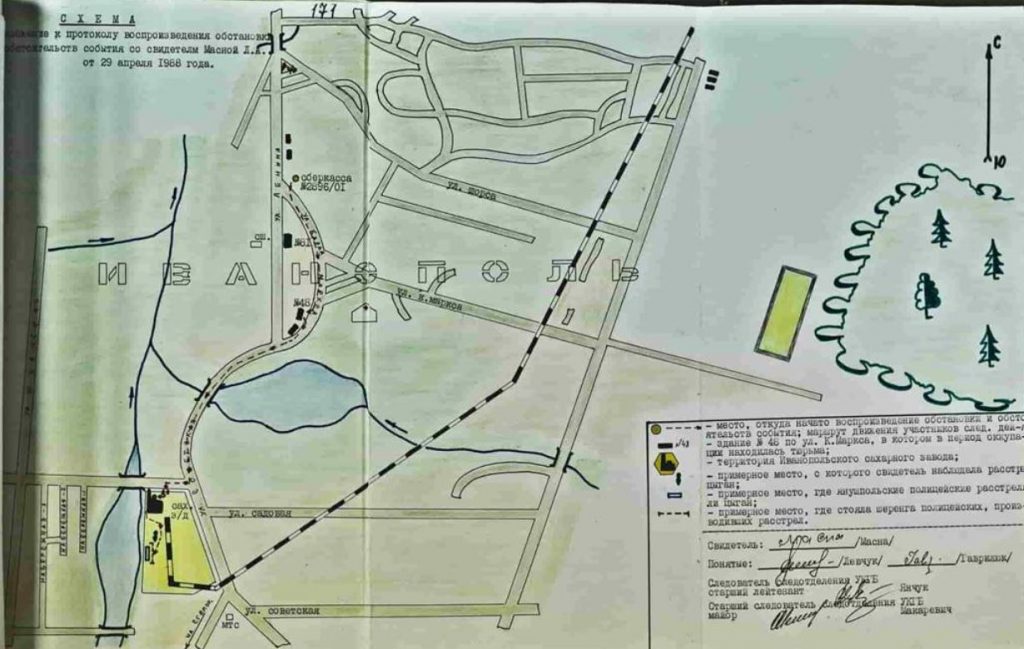
The upswing in the Soviet policy of creating a cult of the Great Patriotic War in the 1960s signified, in particular, greater access to the information space for the voices of direct participants in the war. As Nina Tumarkin writes, during the Stalinist period the publication of memoirs was unthinkable. During the “Thaw,” a number of wartime memoirs came out, written by former officers, partisans, workers of munitions factories, and even former POWs. Nevertheless, the publication of memoirs was strictly controlled. “No deviations from the dominant narrative were permitted.” [28]
The many attempts of the Roma to find refuge in forests and survive persecution on the occupied territory could not have been erased from the memories of Soviet underground members and partisans (which was reflected in their diaries or memoirs). Roma who were interviewed within the framework of recent oral historical projects frequently mention that they sought the help of Soviet partisans or even joined the partisan movement. Nevertheless, their voices were recorded relatively late (starting in the 1990s). [29]
It is crucial to analyze what the perception of Roma was in the essays and stories of those to whom they turned for help. [30] During the preparation of this article, approximately two hundred such publications were examined. Five of them contain mentions of the fate of the Roma during the occupation period and another five recount episodes about encounters and contacts with individual Roma groups (camps or families) in forests. It is important to consider that the memoirs which have been discovered were written not by rank-and-file underground members and partisans but, as a rule, by commanders of partisan detachments and, occasionally, partisan formations.
Most authors describe the Roma whom they encountered in a detached manner, most often with a hint of hostility and superiority on the part of armed and able soldiers toward defenseless people who were unfit for war. If any sympathy and empathy are apparent, they are veiled by the pragmatic attitude of a military man to the Roma as a useless element. In these episodes, Roma are usually first and foremost nomadic, and second, mostly elderly people, women, and children because the men were in the Red Army or had become the first victims of Nazi “security measures”). In the majority of cases, this made it impossible for them to be used in partisan detachments. Some authors have concluded that there was a desire to get rid of this “ballast” and drive the Roma out of areas where partisan detachments were stationed, viewing such measures as well-founded realities of wartime.
At the same time, most authors realize (and mention) that the gypsies were “being persecuted by the Germans on par with the Jews.” For example, some gypsies who came to the woods told Ivan Kolos, the commander of a partisan brigade in Belarus, that the Nazis “were shooting gypsies and Jews without exception.” [31] Oleksii Fedorov, commander of the Chernihiv-Volyn partisan formation, recounting the situation in Volyn in 1943, recalls that entire civilian settlements cropped up there: “There were unique hamlets fashioned out of dugouts—Ukrainian and Polish and Jewish and gypsy.” [32] Yurii Zbanatsky, commander of a partisan detachment in Chernihiv oblast, mentions the execution by the SS of Roma along with Jews and Soviet POWs. [33] In 1942 Anton Brynsky, commander of an operational reconnaissance and sabotage center, was aware of the execution of nearly 150 Roma in Lelchytsy, a small town in southern Belarus. [34] Mykhailo Salai, commander of a partisan formation in the Chernihiv region, offers in his book a detailed description of the execution by the Germans of approximately six hundred Roma in the village of Koriukivka, in Chernihiv oblast. [35] In his diary dated March 1943 the partisan Mykola Sheremet wrote about events that took place in Zhytomyr oblast: “The Germans and the police are persecuting and killing them [Roma] on par with the Jews.” [36]
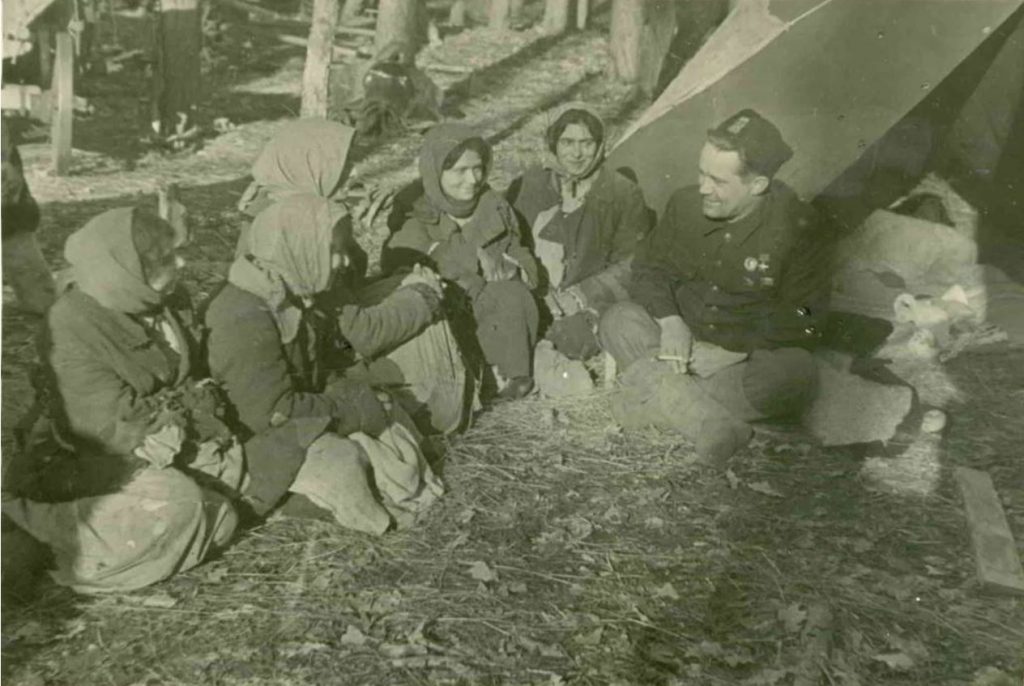
A lengthy episode from the memoirs of Yakiv Shkriabach, commander of a partisan detachment that marched through thirteen oblasts of Ukraine and Belarus, is especially colorful in terms of vocabulary and images. It seems to bring together all the clichés and templates that are found in other texts.
“Heading out on reconnaissance in the direction of the hamlet of Obruchatnitsa, a group of our cavalrymen unexpectedly came upon some bedraggled women and children in a forest clearing. Taking fright, they dashed into the thick of the forest. We spurred the horses, and after a minute we caught up with them. They were gypsies. We saw tents and a few wagons—everything that accompanied this tribe in its nomadic life. Three gypsy men, fifteen gypsy women, and a bunch of dirty, shaggy-haired kids formed the entire camp. There was one horse for five wagons.
– What are you doing here in the forest? we asked. A nimble, young gypsy inspected us carefully.
– We are partisans, gypsy partisans! he replied gravely.
– What are you killing the fascists with? They showed us a rusty rifle with a bolt without an injector, ten cartridges, and a grenade without a capsule.
The story that the gypsies recounted was a sad one. When a German division had come through here, clearing the woods of partisans en route to Yurevychi, the Nazis attacked the gypsies. First, they killed the men. Only a few people managed to escape deep into the woods. During this period the inhabitants of the camp ate the horses. Right now they are eating mushrooms and berries.
A dense crowd of gypsy men and women surrounded us.
“Give me a rifle! I will tell you your fortune, I’ll tell the truth!
“Give me at least a bad horse! You will have luck and great happiness...
“Commander, where is your hand? I’ll tell you the whole truth. Just give us a needle and thread...
“Take this girl of ours. A beautiful gypsy girl? She’s seventeen already. She will come in handy...Give us a horse for the girl!
Finally convinced that we were partisans, the gypsies became bolder and offered us anything in exchange for a ‘horse’ and a ‘rifle.’
They were stationed some four or five kilometers from us. After observing where we had gone, the next day the gypsies came to the camp. ‘We want to tell your fortune.’ Once again, they asked for a needle, thread, horse, and rifle. We ended up having to give them two lame horses and two German rifles with cartridges. At the same time, we warned them not to come to [our] camp anymore. But the next day they reappeared. Only when the partisans threatened them with weapons did the gypsies finally leave us in peace.” [37]
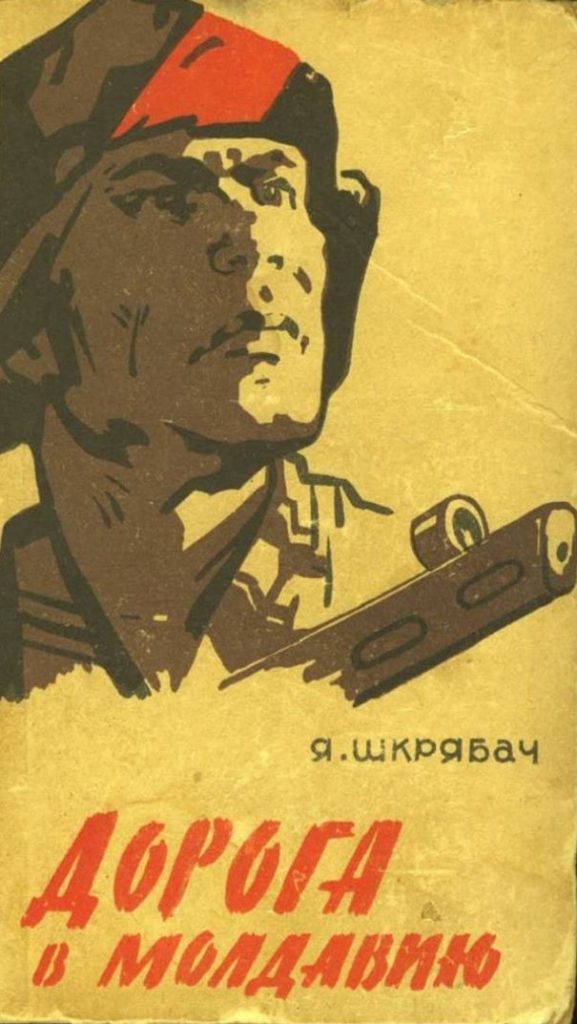 The lexical set of the text reveals its tonality and creates a certain way for readers to perceive the “gypsy.” Roma are “dirty” and “dressed in rags.” Of course, the external appearance of these people could be described this way; after all, they were hiding in the woods. But the point is not how they looked “in reality” but what kinds of portraits are left in the reader’s perception. After communicating with the partisans, the Roma “became bolder.” In exchange for ammunition and a horse, which are indispensable to them, they are unscrupulously ready to give away a girl from the camp. The Roma want to tell fortunes and, like always, they exploit this ability in their survival strategy. Finally, seeking to gain items that are vitally important to them, they “become more boorish,” so much so that they come with their requests over and over again. Of course, the partisans have no choice but to scare them off with their weapons. Why should such people be protected?
The lexical set of the text reveals its tonality and creates a certain way for readers to perceive the “gypsy.” Roma are “dirty” and “dressed in rags.” Of course, the external appearance of these people could be described this way; after all, they were hiding in the woods. But the point is not how they looked “in reality” but what kinds of portraits are left in the reader’s perception. After communicating with the partisans, the Roma “became bolder.” In exchange for ammunition and a horse, which are indispensable to them, they are unscrupulously ready to give away a girl from the camp. The Roma want to tell fortunes and, like always, they exploit this ability in their survival strategy. Finally, seeking to gain items that are vitally important to them, they “become more boorish,” so much so that they come with their requests over and over again. Of course, the partisans have no choice but to scare them off with their weapons. Why should such people be protected?
After having studied individual Roma types, I will note that the memoirs of underground members, partisans, and soldiers from the regular army frequently mention their fellow soldiers of Roma descent as courageous, agile, and resourceful fighters. [38] Indeed, when it came to one or more physically strong young men who also had combat skills, there were no problems with their being accepted into a detachment. It is worth noting here that we learn about cases of the successful service of Roma in partisan detachments mostly from the work of Roma enthusiasts and researchers, who began studying this question only in recent decades (an excellent example is the Bessonov book). In the memoirs of non-Roma authors, such examples are extremely rare.
No less important, however, are other cases where entire families, consisting for the most part of women and children, asked to come under the protection of detachments. In these situations, the authors describe the Roma mostly as a foreign or, at best, neutral and politically unaware element that does not elicit empathy in readers or encourage them to give them assistance. The hundreds of thousands of copies of memoirs that were published were placed in libraries for children and adults, where there was a considerable demand for them among readers. They influenced the formation of ideas both about the war in general and about the images of victims of the occupation in particular. The group portrait of the Roma, as represented by the authors of memoirs, did not fit into the collective ideas about the heroic struggle against the enemy and therefore did not elicit empathy in readers.
Special to Ukraїna Moderna. Published here for the first time. Reproducing the text (partially or in its entirety) requires permission from the author or the editorial office of the Ukraїna Moderna Web site. ©Mykhail Tyaglyy.
All illustrations supplied by the author.
This article was supported by a research stipend awarded by Imre Kertész Kolleg Jena. The author is grateful to the team and fellow stipend-holders at Imre Kertész Kolleg Jena for their fruitful discussions and valuable advice.
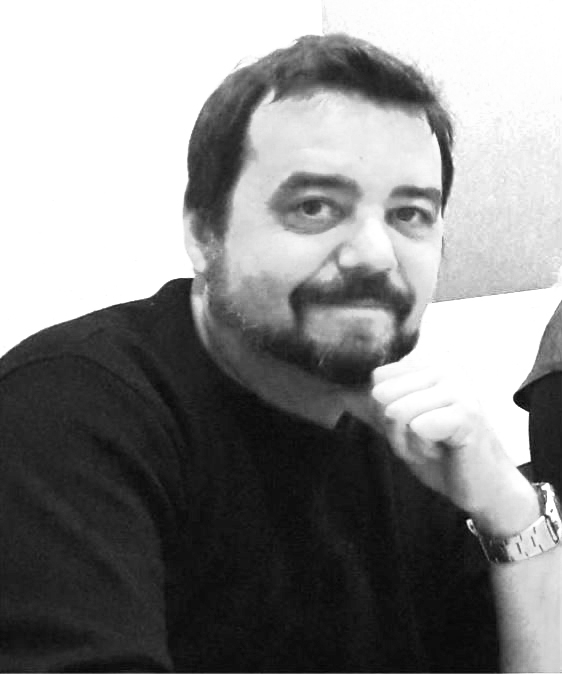 Mykhailo Tiahlyi is a scholarly associate of the Ukrainian Center for Holocaust Studies (Kyiv), managing editor of the scholarly journal Holokost і suchasnist. Studiї v Ukraїni і sviti (Holocaust and Modernity: Studies in Ukraine and the World). His academic interests include the history of the Holocaust, the Roma genocide, studies of the memory of genocide victims, and the specific character of teaching the history of the Holocaust and other genocides. He is the author of a number of works about the Holocaust in the Crimea, the course and consequences of the Nazis’ anti-Roma policy in Ukraine; the compiler of a collection of documents and curator of an educational history exhibit devoted to these questions; and the scholarly editor of Ukrainian translations of studies in Holocaust history.
Mykhailo Tiahlyi is a scholarly associate of the Ukrainian Center for Holocaust Studies (Kyiv), managing editor of the scholarly journal Holokost і suchasnist. Studiї v Ukraїni і sviti (Holocaust and Modernity: Studies in Ukraine and the World). His academic interests include the history of the Holocaust, the Roma genocide, studies of the memory of genocide victims, and the specific character of teaching the history of the Holocaust and other genocides. He is the author of a number of works about the Holocaust in the Crimea, the course and consequences of the Nazis’ anti-Roma policy in Ukraine; the compiler of a collection of documents and curator of an educational history exhibit devoted to these questions; and the scholarly editor of Ukrainian translations of studies in Holocaust history.
[2] Velikaia Otechestvennaia voina sovetskogo naroda: Annotirovannyi ukazatel′ literatury za god voiny (Moscow: Gosudarstvennoe bibliotechno-bibliograficheskoe izdatel′stvo NKP RSFSR, 1942), 86–88.
[3] Kotljarchuk, “Invisible Victims,” 143.
[4] Kotljarchuk, “Memory of Roma Holocaust in Ukraine,” 149–76.
[5] Ibid., 32.
[6] Ibid., 153.
[7] “Sudebnyi protsess: Po delu o zverstvakh nemetsko-fashistskikh v gor[ode]. Nikolaeve i Nikolaevskoi oblasti,” Izvestiia, 12 January 1946, 5; Pravda, 12 January 1946, 5.
[8] “Sudebnyi protsess po delu o zlodeianiiakh nemetsko-fashistskikh zakhvatchikov na territorii Litovskoi, Latviiskoi, i Estonskoi SSR,” Izvestiia, 12 January 1946, 3.
[9] “Palach pol′skogo naroda pered sudom,” Pravda, 24 June 1946, 6.
[10] “Sud nad Manshteinom,” Izvestiia, 11 September 1949, 4.
[11] T. Gerasimova, “Ne uiti ot vozmezdiia,” Izvestiia, 18 January 1962, 6.
[12] N. Pavlov, “Ot rasplaty ne ushli,” Izvestiia, 11 March 1966, 4.
[13] For an example of a work that examines the interaction between the ideological bodies of the Communist Party in Moscow and the elites of the Ukrainian SSR in formulating a history policy for key questions of Russian-Ukrainian history, see S. Iekel′chyk, Imperiia pam’iati: Rosiis′ko-ukraїns′ki stosunky v radians′kii istorychnii uiavi, trans. from the English M. Klymchuk and Kh. Chushak (Kyiv: Krytyka, 2008).
[14] In 1943–1953 Soviet military tribunals and other special courts convicted nearly 320,000 persons accused of collaborating with the occupiers. Approximately 90,000 were from the Ukrainian SSR. See O. Mozokhin, Pravo na repressii: Vnesudebnye polnomochiia organov gosudarstvennoi bezopasnosti (1918–1953) (Moscow: Kuchkovo pole, 2006), 481–626.
[15] T. Penter, “Local Collaborators on Trial: Soviet War Crimes Trials under Stalin (1943–1953),” Cahiers du monde russe, no. 49 (2008): 341–64.
[16] Prusin, “‘Second Wave’ of Soviet Justice,” 150.
[17] O. Melnyk, “Historical Politics, Legitimacy Contests, and the (Re)-Construction of Political Communities in Ukraine during the Second World War” (PhD dissertation, University of Toronto, 2016); A. Usach, “‘Shchob vony bil′sh ne khodyly po nashii sviatii zemli’: KDB URSR і polityka pam’iati pro mistsevu kolaboratsiiu, 1960–1980-ti rr.,” Problemy istoriї Holokostu, no. 10 (2018): 42–64; Sklokina, “Trials of Nazi Collaborators,” 345–64.
[18] Not to be confused with the open trial of Hungarian soldiers, which was also held in Chernihiv on 17–25 November 1947.
[19] P. Mykhailov, “Vbyvtsi radiansk′kykh liudei,” Desnians′ka pravda, 18 April 1944; “Sudovyi protses pro masovi rozstrily radians′kykh liudei u chernihivs′kii tiurmi pid chas nimets′koї okupatsiї,” Desnians′ka pravda, 19 April 1944; “Sudovsyi protses pro masovi rozstrily radians′kykh liudei u chernihivs′kii tiurmi pid chas nimets′koї okupatsiї; Iz zaly sudu,” Desnians′ka pravda, 21 April 1944, 22 April 1944, 23 April 1944.
[20] “Zradnyky Bat′kivshchyny pered sudom narodu,” Zoria, 29 January, 1945.
[21] See the articles on the front pages of the newspaper Artemovskii rabochii, 15, 16, and 18 January 1944.
[22] M. Tyaglyy, “Stavlennia mistsevoho naselennia v okupovanii Ukraїni do peresliduvannia romiv (1941–1944),” in Henotsyd romiv Ukraїny v period Druhoї svitovoї viiny: Vyvchennia, vykladannia, komemoratsiia; Materialy naukovo-praktychnoї konferentsi (Kyїv, 4 zhovtnia 2016 r.) (Kyiv: Ukraїns′kyi tsentr vyvchennia istoriї Holokostu, 2016), 148.
[23] Arkhiv upravlinnia SBU v Zhytomyrs′kii ob., arkh.-krym. spr. № 326 (1947 r.); arkh.-krym. spr. № 700 (1948 r.); arkh.-krym. spr. № 1486 (1946 r.); arkh.-krym. spr. № 15048 v 2-kh тт. (1953 r.).
[24] Arkhiv upravlinnia SBU v Zhytomyrs′kii ob., arkh.-krym. spr. № 32437 (1988–1989 rr.); arkh.-krym. spr. № 32446 (1990–1991 rr.).
[25] Interview with D. Sovyns′kyi, a resident of the village of Ivanopil; author’s archive.
[26] P. Shpyta, “Vyrok na sudovomu protsesi v Ivanopoli,” Prapor komunizmu, 20 April 1989.
[27] P. Shafeta, Stroku davnosti ne isnuie (Kyiv: Vydavnytstvo TsK LKSMU “Molod′,” 1984), 88–89.
[28] Tumarkin, Living and the Dead, 134–35.
[29] The most ambitious although not always high-quality results were produced by the project “Survivors of the Shoah Visual History Foundation,” which recorded 135 interviews with Roma who survived the genocide in Ukraine. For a description of the project and its Roma component, see A. Lenchovs′ka, “Videosvidchennia Instytutu Fondu Shoa iak dzherelo do vyvchennia ta vykladannia istoriї romiv Ukraїny u period 1941–1944 rr.,” Holokost і suchasnist′: Studiї v Ukraїni і sviti, no. 2 (2009): 114–23.
[30] Of course, Soviet partisans were not the only organized force operating in the poorly controlled territories of the USSR. Thus, the memoirs of members of other armed formations should be studied for the presence of testimonies about Roma. As concerns the Ukrainian lands, these are the formations of the Security Service of the Organization of Ukrainian Nationalists and the Ukrainian Insurgent Army. Such evidence, although scarce, does exist (Tyaglyy, “Stavlennia mistsevoho naselennia,” 128–36). However, since these kinds of memoirs were not published in the USSR in the postwar period—nor could they have been—they had no impact on Soviet society’s picture of the memory of the war. Therefore, they are not examined in this article.
[31] I. Kolos, Za chas do rassveta: Dokumental′no-prikliuchencheskaia povest′, trans. from the Ukrainian (Moscow: Detskaia literatura, 1979), 46.
[32] A. F. Fedorov, Podpol′nyi obkom deistvuet (Moscow: Voenizdat, 1955), 231.
[33] Iu. Zbanatskii [Zbanats′kyi], Krasnaia rosa: Roman, povesti, trans. from the Ukrainian (Moscow: Sovetskii pisatel′, 1987), 125.
[34] A. Brinskii, Po tu storonu fronta, 2 vols. (Gorky: Volgo-Viatskoe knizhnoe izdatel′stvo, 1966), 367.
[35] M. G. Salai, Po znakomym dorogam: Zapiski starogo partizana (Moscow: DOSAAF, 1981), 59.
[36] M. Sheremet, “V tylu voroha (6 bereznia–1 kvitnia 1943 r.),” in Partyzans′ki kolektsiї Natsional′noho muzeiu istoriї Ukraїny u Druhii svitovii viini; Shchodennyky (Kyiv, Aerostat, 2015), 176 (recording dated 22 March 1943).
[37] Ia. P. Shkriabach, Doroga v Moldaviiu: Vospominaniia komandira (Kishinev: Kartia Moldoveniaske, 1966).
[38] The stories of Roma members of the Soviet partisan movement are collected and cited by N. Bessonov, Tsyganskaia tragediia, vol. 2 Vooruzhennyi otpor (St. Petersburg: Shatra, 2010), 268–310.
The accuracy of the facts and quotations cited in this article is the sole responsibility of the authors of the texts.
Originally appeared in Ukrainian @Ukraina Moderna
Translated from the Ukrainian by Marta D. Olynyk.
Edited by Peter Bejger.
NOTE: UJE does not necessarily endorse opinions expressed in articles and other materials published on its website and social media pages. Such materials are posted to promote discussion related to Ukrainian-Jewish interactions and relations. The website and social media pages will be places of information that reflect varied viewpoints.



















